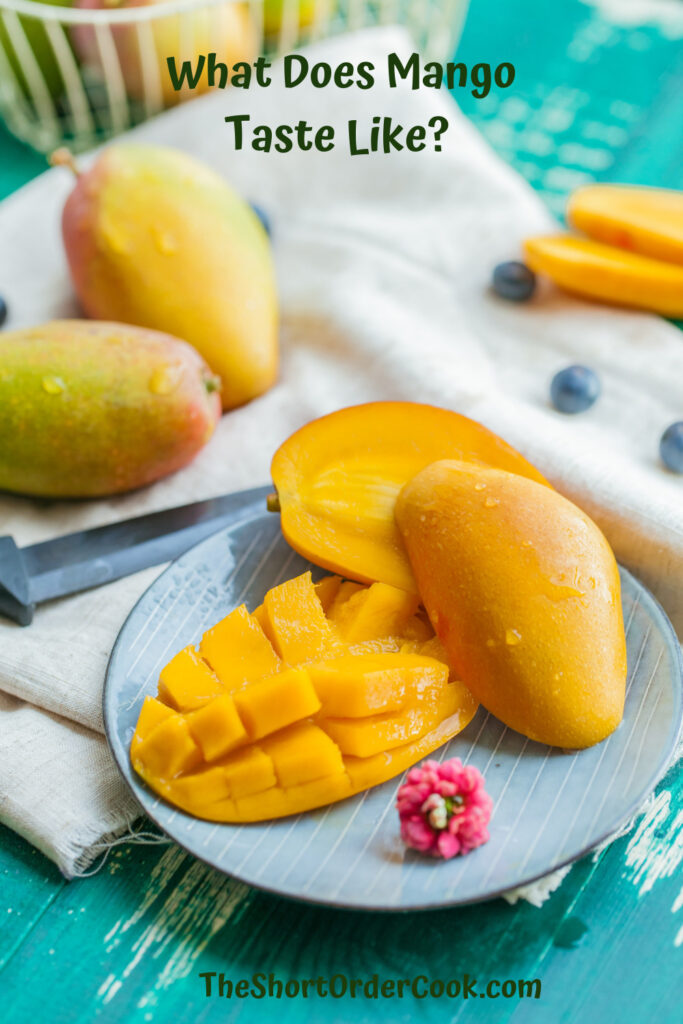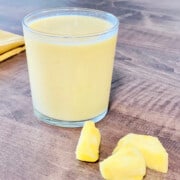For anyone who has never tried a mango before, you may be wondering what does a mango taste like. To better understand how it tastes, it is good to find out more about them. They are large oval-shaped sweet fruits with yellowish flesh. The outside skin comes in a variety of colors such as yellow, orange, red, green, and all combinations thereof.

There are many different types of mangoes, over 1500 to be exact. The most popular varieties offered in America include such names as Honey, Francis, Haden, Keitt, Kent, & Tommy Atkins. They all relatively taste the same but may come into season at different times of the year, grow in different regions or climates, and have various sizes, flesh, and skin types.
Jump to:
How to Choose or Cut Mangos
Does a mango's taste become affected by its ripeness? It absolutely does. Enjoy your mango at the peak of ripeness for it to be sweet and juicy. Be sure yours is ripe so it is flavorful otherwise, they will be rubbery in texture, not at all juicy, a tad sour instead of sweet, and be a bit bland.
When choosing a mango at the store or farmer's market, pick them based on when you want to eat them. If you need some for dinner tonight or tomorrow you want ripe ones. If you want to enjoy them in a few days, pick firm ones and take them home to ripen.
Mangoes are ripe when they give just slightly when pressed. It needs to yield a little bit otherwise if it is still hard it is an unripe mango so wait another day or two. This is similar to how you pick out an avocado.
Mangoes are tropical fruits with a large flat pit on the inside. Their oval shape and awkward pit shape make them difficult to cut. There is a great mango cutter you can buy that helps cut and pit them all at once.
See below on how to order one, they work great and are inexpensive. If you do not have one, no worries you can still cut a mango easily. Do not be intimidated, follow these instructions and learn How To Cut A Mango.

What Does Mango Taste Like?
A ripe fresh mango can be described as tasting sweet, citrus, and almost melon flavor all in one. I think of them as a combination of peach, orange, and cantaloupe. Because of the way mango smells, I also find them to have a floral and tropical, like papaya and pineapple taste to them. They are a mild-tasting fruit that is sweet and a bit tart.
I have heard a few people think they taste like pine, which seems odd but apparently, five out of six compounds that are found in pine needles are also found in mango pulp. However, for most people, I think the thing that stands out the most when eating a mango is the texture and smell along with the actual taste.
It is hard to talk about the taste and eating a mango without addressing the smooth, juicy, and velvety consistency of the flesh. This makes them fantastic to eat alone, in desserts, and in savory dishes like salads.
Health Benefits & Nutrition Information for Mangoes
They're packed full of beta-carotene, a powerful antioxidant, and over 10 vitamins and minerals. They are especially high in Vitamin C with over 67% of your daily dietary needs in just 1 cup. They are packed with fiber as well which makes them a great food to help with digestion. Mangoes should be enjoyed regularly as part of a healthy diet. To find out more, read about the Health Benefits of Mangoes.
You can even feed mango to your dog. They are high in sugar, so limit them to only 1-2 ounces a week. But dogs can eat mangos and is a good special occasion treat.
Recipes Using Mangoes & How to Eat Them
There are so many great ways to enjoy mangoes. I grew up eating fresh mango with cottage cheese or yogurt for breakfast all the time. Mango can be enjoyed as an appetizer, for breakfast, a snack, in the main entree with proteins, or even in desserts.
It is a very versatile fruit that works in both savory and sweet recipes. For savory ideas to use mangoes try them with proteins in a stir fry or in salads. For sweet mango recipe ideas, they can be used to in cakes, smoothies, cobblers, and more.



How to Store & Can You Freeze Mangoes
Store mangoes on your kitchen counter, do not put them in your refrigerator especially if they are not ripe yet. I do something to chill them just a bit when making smoothies to have it cool vs. warm but that is just for a short period of time. To store partially used mangoes, I diced them and stored them in an air-tight container.
You can freeze mangoes. To freeze them, the best two methods are either by mashing them or sealing them in an air-tight ziplock container. Make sure to squeeze all the air out to ensure there is no freezer burn which will ruin the frozen mango.
Also, flash-freeze chunks or slices by laying them in a single layer in the freezer on a parchment paper-lined tray for about 30 minutes. Once solid, remove them and place them in an air-tight ziplock or container.
Defrost frozen mangoes in the refrigerator for 1-2 days. You will want to use them immediately and make sure that no air is getting to the flesh as it defrosts or it will brown and discolor. Thawed mango is great to use in ice cream, smoothies, baked goods, and more.

Product Recommendations for this Article:
The Short Order Cook is a participant in the Amazon Services LLC Associates Program. As an Amazon Associate, I earn from qualifying purchases. If you click on a link and make a purchase, I may earn a small commission on the sale at no additional cost to you. This helps with the costs of running the blog. Thank you!






Caroline Parrott says
OMG! Before I read your description of the taste, I had already formulated a comment in my mind thinking , "oh I hope Short Order Cook addresses that juniper/pine essence of mangoes." It is significant to my taste buds, and not in a bad way. Mangoes, while I don't enjoy cutting and peeling them, truly are an interesting, fun fruit!